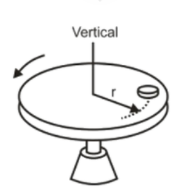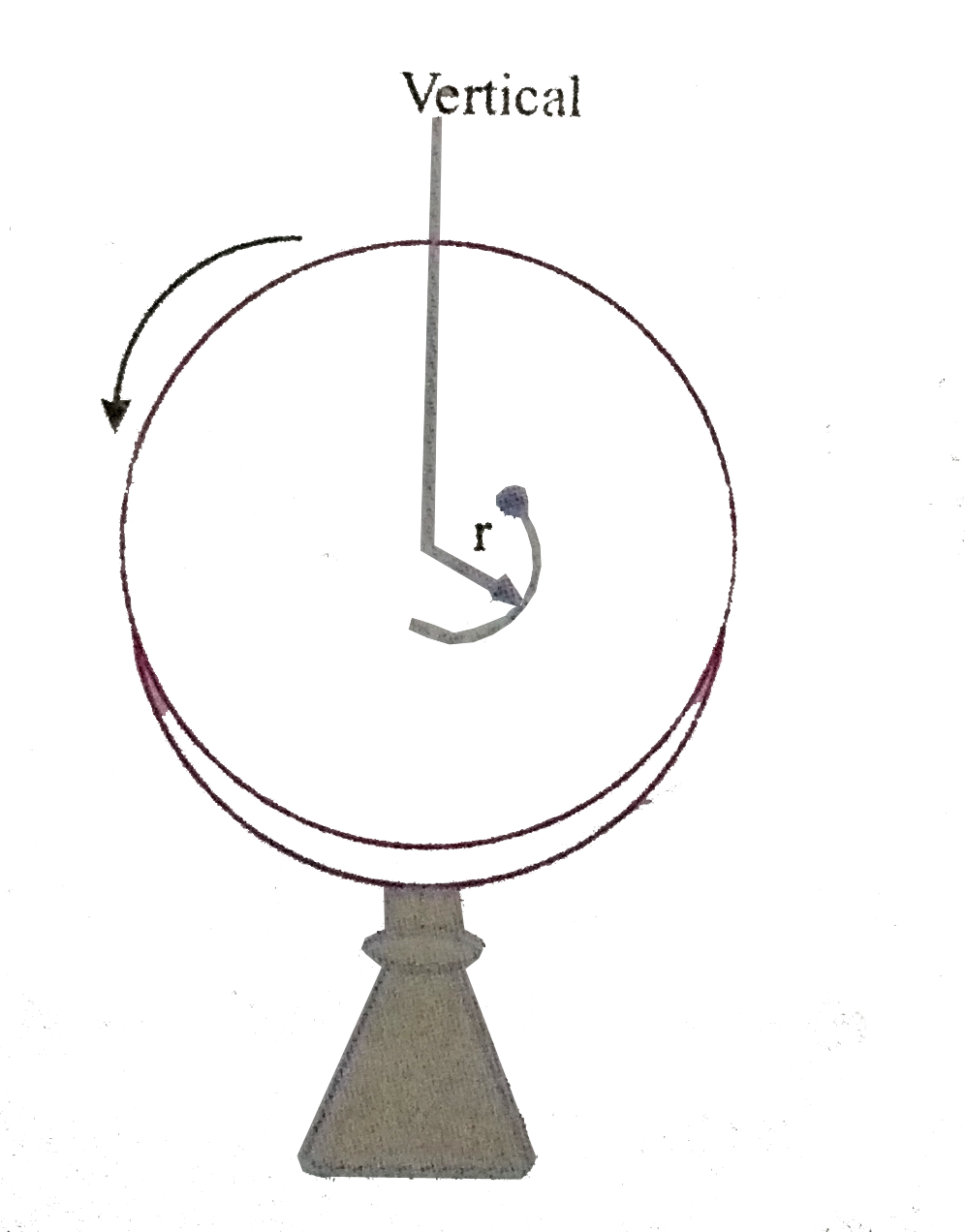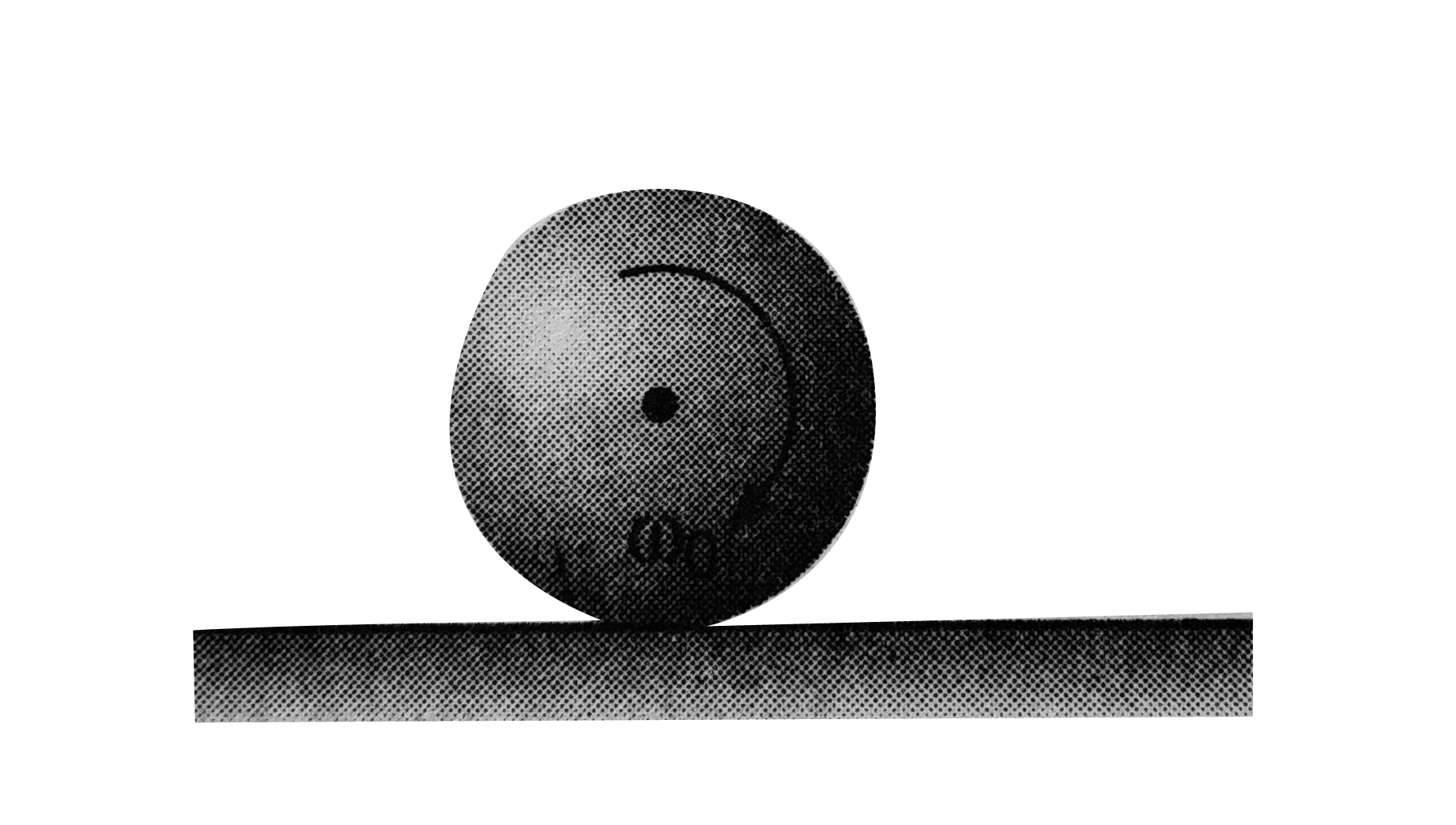A solid disc and a ring, both of radius 10cm are placed on a horizontal table simultaneously, with initial angular speed equal to 10πrad/s. Which of the two will start to roll earlier ? The coefficient of kinetic friction is μk=0.2.
To solve the problem of determining which object, a solid disc or a ring, will start to roll earlier when both are placed on a horizontal table with an initial angular speed of 10π rad/s, we need to analyze the motion of both objects under the influence of kinetic friction.
1. Identify Given Data:
- Radius of both the disc and the ring, R=10cm=0.1m
- Initial angular speed, ω0=10πrad/s
- Coefficient of kinetic friction, μk=0.2
2. Determine the Forces Acting on Each Object:
- The only horizontal force acting on both the disc and the ring is the kinetic friction force, which acts in the direction opposite to the motion due to the initial angular speed.
- The friction force can be calculated as:
Fk=μk⋅N=μk⋅mg
- Here, N is the normal force, which equals the weight mg of the object.
3. Calculate the Acceleration of the Center of Mass:
- The acceleration of the center of mass acm due to friction is given by:
acm=Fkm=μkg
- Substituting the values:
acm=0.2⋅10m/s2=2m/s2
4. Determine the Torque and Angular Acceleration:
- The torque τ due to friction about the center of mass for both objects is:
τ=Fk⋅R=μkmgR
- The moment of inertia I for the disc is 12mR2 and for the ring is mR2.
- The angular acceleration α can be calculated using:
τ=Iα⟹α=τI
- For the disc:
αdisc=μkmgR12mR2=2μkgR
- For the ring:
αring=μkmgRmR2=μkgR
5. Calculate the Time to Start Rolling:
- The condition for pure rolling is when the linear velocity of the center of mass vcm equals the tangential velocity at the point of contact vt=Rω.
- The linear velocity of the center of mass increases due to acceleration:
vcm=acm⋅t=μkgt
- The angular velocity decreases due to angular acceleration:
ω=ω0−αt
- Setting vcm=Rω:
μkgt=R(ω0−αt)
- For the disc:
μkgt=R(10π−2μkgRt)
- For the ring:
μkgt=R(10π−μkgRt)
6. Solve for Time t for Both Objects:
- Rearranging the equations will yield the time taken for each object to start rolling:
- For the disc:
tdisc=10πRμkg+2μkg=10πR3μkg
- For the ring:
tring=10πRμkg+μkg=10πR2μkg
7. Compare the Times:
- Since tdisc involves a factor of 3 in the denominator and tring involves a factor of 2, it is clear that:
tdisc>tring
- Therefore, the ring will start to roll earlier than the disc.
Conclusion:
The ring will start to roll earlier than the solid disc.
- Radius of both the disc and the ring, R=10cm=0.1m
- Initial angular speed, ω0=10πrad/s
- Coefficient of kinetic friction, μk=0.2
- The only horizontal force acting on both the disc and the ring is the kinetic friction force, which acts in the direction opposite to the motion due to the initial angular speed.
- The friction force can be calculated as:
Fk=μk⋅N=μk⋅mg
- Here, N is the normal force, which equals the weight mg of the object.
- The acceleration of the center of mass acm due to friction is given by:
acm=Fkm=μkg
- Substituting the values:
acm=0.2⋅10m/s2=2m/s2
- The torque τ due to friction about the center of mass for both objects is:
τ=Fk⋅R=μkmgR
- The moment of inertia I for the disc is 12mR2 and for the ring is mR2.
- The angular acceleration α can be calculated using:
τ=Iα⟹α=τI
αdisc=μkmgR12mR2=2μkgR
- For the ring:
αring=μkmgRmR2=μkgR
- The condition for pure rolling is when the linear velocity of the center of mass vcm equals the tangential velocity at the point of contact vt=Rω.
- The linear velocity of the center of mass increases due to acceleration:
vcm=acm⋅t=μkgt
- The angular velocity decreases due to angular acceleration:
ω=ω0−αt
- Setting vcm=Rω:
μkgt=R(ω0−αt)
μkgt=R(10π−2μkgRt)
- For the ring:
μkgt=R(10π−μkgRt)
- Rearranging the equations will yield the time taken for each object to start rolling:
- For the disc:
tdisc=10πRμkg+2μkg=10πR3μkg
- For the ring:
tring=10πRμkg+μkg=10πR2μkg
- Since tdisc involves a factor of 3 in the denominator and tring involves a factor of 2, it is clear that:
tdisc>tring
- Therefore, the ring will start to roll earlier than the disc.
The ring will start to roll earlier than the solid disc.
Topper's Solved these Questions
- BOOK - PRADEEPCHAPTER - SYSTEMS OF PARTICLES AND ROTATIONAL MOTIONEXERCISE - QUESTIONS15videos
SYSTEMS OF PARTICLES AND ROTATIONAL MOTION
- BOOK - PRADEEPCHAPTER - SYSTEMS OF PARTICLES AND ROTATIONAL MOTIONEXERCISE - VALUE BASED QUESTIONS5videos
SYSTEMS OF PARTICLES AND ROTATIONAL MOTION
- BOOK - PRADEEPCHAPTER - SYSTEMS OF PARTICLES AND ROTATIONAL MOTIONEXERCISE - NCERT21videos
SYSTEMS OF PARTICLES AND ROTATIONAL MOTION
- BOOK - PRADEEPCHAPTER - RAY OPTICSEXERCISE - Problem For Practice(a)25videos
RAY OPTICS
- BOOK - PRADEEPCHAPTER - THERMODYNAMICSEXERCISE - Assertion- Reason Type Questions19videos
THERMODYNAMICS
Similar Questions
A cylinder of mass 5kg and radius 10cm is moving on a horizontal surface with speed. 5m/s and angular speed about axis through C.M.10rad/s. Find the angular momentum of the cylinder about point of contact.
View SolutionA small coin of mass 40 g is placed on the horizontal surface of a rotating disc. The disc starts from rest and is given a constant angular acceleration α=2 rad s−2. The coefficient of static friction between the coin and the disc is μs=3/4 and the coefficient of kinetic friction is μk=0.5. The coin is placed at a distance r=1m from the centre of the disc. The magnitude of hte resultant force on the coin exerted by the disc just before it starts slipping on the disc is :
 View Solution
View Solution
Knowledge Check
- Question 1 - Select One
A ring of radius R is rotating with an angular speed ω0 about a horizontal axis. It is placed on a rough horizontal table. The coefficient of kinetic friction is μk. The time after it starts rolling is.
Aω0μkR2gBω0g2μkRC2ω0RμkgDω0R2μkg - Question 2 - Select One
A ring of radius R is rotating with an angular speed ω0 about a horizontal axis. It is placed on a rough horizontal table. The coefficient of kinetic friction is μk. The time after it starts rolling is.
Aω0μ1R2gBωaR2μgRC2ω0RωkgDω0R2μgg - Question 3 - Select One
A small coin of mass 80g is placed on the horizontal surface of a rotating disc. The disc starts from rest and is given a constant angular acceleration α=2rad/s2. The coefficient of static friction between the coin and the disc is μs=3/4 and cofficient of kinetic friction is μk=0.5. The coin is placed at a distance r=1m from the centre of the disc. The magnitude of the resultant force on the coin exerted by the disc just before it starts slipping on the disc is
 A0.2NB0.3NC0.4ND1N
A0.2NB0.3NC0.4ND1N

solid sphere of radius r is gently placed on a rough horizontal ground with an initial angular speed ω0 and no linear velocity. If the coefficient of friction is μ, find the time t when the slipping stops. in addition state the linear velocity v and angular velocity ω at the end of slippingView SolutionA ring of radius 0.5 m and mass 10 kg is rotating about its diameter with angular velocity of 20 rad/s. Its KE is :-
View SolutionA solid sphere of mass 1 kg and radius 10 cm rolls without slipping on a horizontal surface, with a velocity of 20 cm/s. The total kinetic energy of the sphere is
View SolutionA solid sphere of mass 1 kg and radius 10 cm rolls without slipping on a horizontal surface, with a velocity of 20 cm/s. The total kinetic energy of the sphere is
View SolutionA uniform circular ring of radius R is first rotated about its horizontal axis with an angular velocity ω0 and then carefully placed on a rough horizontal surface as shown. The coefficient of friction between the surface and the rings μ. Time after which its angular speed is reduced to 0.5ω0 is
 View Solution
View Solution

